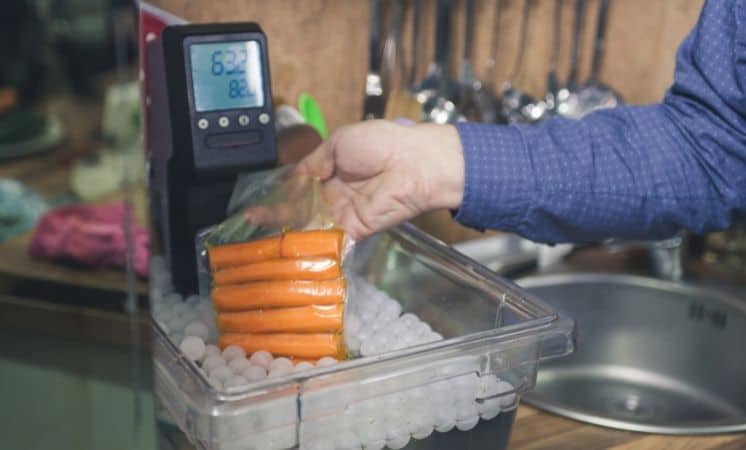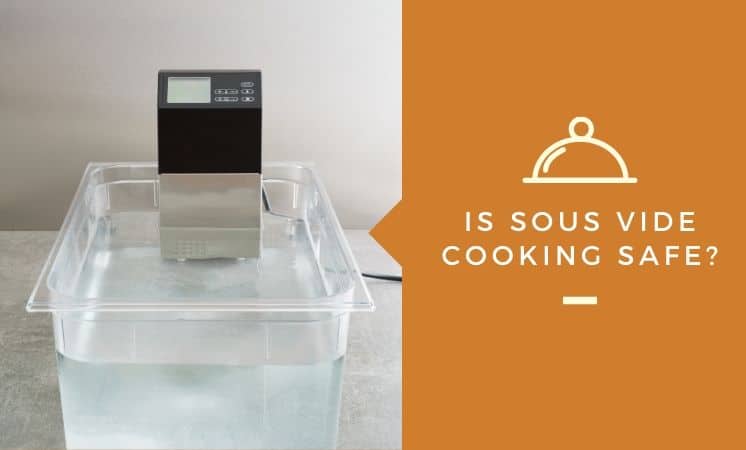The reputation of perfectly cooked steaks, tender pork, and juicy chicken breasts is popularizing sous vide, a cooking method that until recently, was mainly used by highly trained professional chefs in five-star restaurants.
The method of sous vide involves placing your food into vacuum-sealed bags and submerging them into a water bath to cook at a precise and controlled temperature. For most, the idea of eating food that has been cooked in a plastic bag brings up many concerns about safety.
So, is sous vide cooking safe? The answer to this is, yes. Cooking with sous vide is safe to do as long as you are keeping your food out of the temperature danger zone and you are using food-grade bags.
The concern for safety comes from chemicals leaching into the food, from the potential for food-borne illnesses like Salmonella poisoning, and from ensuring that food cooks all the way through.
We explore whether sous vide is safe for pregnant women, whether it is a healthy alternative, and whether it kills off bacteria. Read on to find out how safe sous vide actually is!
Is Sous Vide Safe When Pregnant?
Women who are pregnant should not restrict their diet to specific foods but should make sure that all food that is consumed is fresh, clean, and cooked properly. You do not want to consume any food that has preservatives or is undercooked or raw.
Due to this, sous vide is a fantastic cooking method for pregnant women and is considered a “low-risk” with regards to issues of food safety. With sous vide, the food is evenly cooked throughout and will cook to the temperature you require gradually over a long length of time.
If you are planning on eating any type of meat that is done via the sous vide method and you are pregnant, please make sure that the meat has been completely pasteurized in order to avoid pathogens that would make you ill (this also goes for those who are not pregnant or could become pregnant).
Is Sous Vide Healthier?
When compared to other traditional methods of cooking, sous vide does come out on top in the healthier category and here is why.
Sous Vide Retains Nutrients & Vitamins.
When you expose your food to high temperatures that come with boiling, frying or steaming, you destabilize and break down a large portion of the nutrients in your food.
These nutrients are lost because they leach out of the food or because they get charred away by overcooking/burning. With sous vide, you keep all of the nutrients and vitamins sealed within the pouch.
This ensures that more nutrients are kept on the food and in the food, and presumably consumed by you. The more vitamins and nutrients you consume, the healthier your body will be.
Food Is Easier to Digest.
Cooking your food allows the nutrients to become bioavailable, meaning that they are easier to access and absorb during digestion. While many vegetables require some cooking to have their nutrients become bioavailable, it is with animal proteins where we see the most benefit.
Animal proteins like fish, chicken, pork, and lamb have a lot of collagen in them which is amazing for our hair, skin, and nails. However, it can be hard for the body to absorb.
When you cook with sous vide, you are more likely to break down the collagen into gelatin, which is easier for your body to absorb.
You Will Have Stronger Joints & a Happier Gut.
In talking about collagen, it plays a critical role in how healthy your connective tissue is. This includes your ligaments, your tendons, and your fascia which is the band of connective tissue that sits beneath your skin and stabilizes and attaches it to muscles and internal organs.
Collagen normalizes your gut hormones, helps prevent wrinkly skin, and gives your connective tissue the nutrients it needs to continue to support your body.
Additional Fats Are Not Required.
With sous vide, you do not have to worry about your food sticking to your cooking surface like you would with pan-frying. Therefore, you don’t need extra fats like butter or oil during the cooking process. This ensures that you only get the good fats that you need from the food without adding any extra.
You Can Prepare Meals in Advance.
While all of us love to have healthy meals that are delicious and tasty, there’s no doubt about it that they can take a long time to prepare and cook.
This has a lot of people reaching for fast food menus or highly processed foods because of how convenient they are.
With sous vide, you can prepare larger quantities of healthy meals in advance and encourage less eating out and more home-cooked meals. If you want to be your best self, you must eat well. Trust us, your body will thank you.

When you choose to make meals at home, you consume fewer calories and fewer grams of carbohydrates, salts, and fats.
When you cook with sous vide, not only are you avoiding the loss of nutrients and minimizing how much additives you use, but you are consuming food that is easier to absorb and is as close to its natural form as you can get.
In having complete and precise control over how your food cooks and what goes into the pouch, you can dictate a healthier life.
Does Sous Vide Kill Parasites and Bacteria?
One of the main ways that food spoils is by being in the temperature “danger zone” which is the range of 40 degrees Fahrenheit to 140 degrees Fahrenheit or 4 degrees Celsius to 60 degrees Celsius.
Any food like eggs, meat, seafood, cooked vegetables, pasta, beans, and raw sprouts, that is left within this temperature range for longer than two hours is susceptible to bacterial growth and parasites.
If you consume food that has been within this danger zone can result in you developing a food-borne illness. Luckily, all known pathogenic bacteria are killed below 131 degrees Fahrenheit, which is why most recipes recommend cooking your food at 140 degrees Fahrenheit or higher.
With sous vide, most recipes are completely pasteurized before you consume them, deeming them safe and free of pathogens. To pasteurize your food, you need to keep the food at a specific temperature for a certain amount of time and allow it to reach that temperature all the way through its core.
The temperature required is dependent on what you are cooking
For instance, a one-inch chicken breast is to be cooked at 165 degrees Fahrenheit or 74 degrees Celsius in order to pasteurize it. When the core of the chicken breast reaches this temperature, virtually all Salmonella (a food-borne bacteria) is killed off immediately.
Now let’s lower that number to 150 degrees Fahrenheit or 65.5 degrees Celsius; it takes 3 minutes for all Salmonella to be killed off. So, if you are cooking a one-inch chicken breast in sous vide at 150 degrees Fahrenheit, you would need to leave it for 47 minutes in order to kill off all Salmonella.
It is important to note that you will need to add time to compensate for the amount of time it takes the food to reach that temperature, so for the chicken breast example, if you want to pasteurize it completely, it would need to sit in sous vide for 1 hour and 36 minutes.
In short, yes sous vide does kill off bacteria and parasites in so long as you are cooking above 131 degrees Fahrenheit for longer than 30 minutes.
What About All That Plastic?
In so long as you are using food-grade plastic bags, it is generally safe. It has been found that some types of plastic do leach undesirable chemicals into food like Bisphenol-A (BPA), which is why many people have stopped reusing plastic containers for food storage.
However, just make sure that you are using high-density polyethylene or polypropylene bags, as these are resistant to sub-boiling temperatures that sous vide cooking uses. If you are worried about additives, look for manufacturers that do not use plasticizers in their bags.

